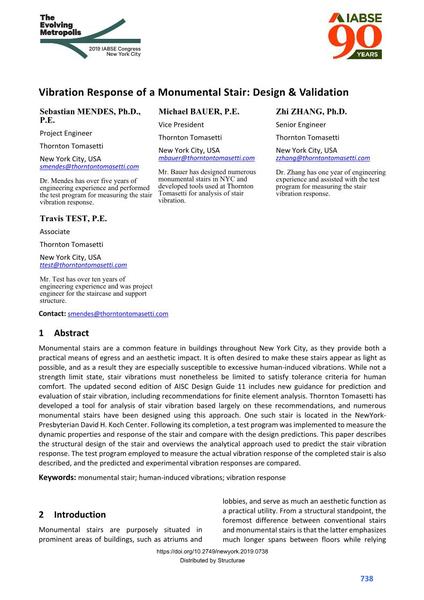Vibration Response of a Monumental Stair: Design & Validation

|
|
|||||||||||
Bibliografische Angaben
| Autor(en): |
Sebastian Mendes
(Thornton Tomasetti)
Michael Bauer (Thornton Tomasetti) Zhi Zhang (Thornton Tomasetti) Travis Test (Thornton Tomasetti) |
||||
|---|---|---|---|---|---|
| Medium: | Tagungsbeitrag | ||||
| Sprache(n): | Englisch | ||||
| Tagung: | IABSE Congress: The Evolving Metropolis, New York, NY, USA, 4-6 September 2019 | ||||
| Veröffentlicht in: | The Evolving Metropolis | ||||
|
|||||
| Seite(n): | 738-743 | ||||
| Anzahl der Seiten (im PDF): | 6 | ||||
| DOI: | 10.2749/newyork.2019.0738 | ||||
| Abstrakt: |
Monumental stairs are a common feature in buildings throughout New York City, as they provide both a practical means of egress and an aesthetic impact. It is often desired to make these stairs appear as light as possible, and as a result they are especially susceptible to excessive human-induced vibrations. While not a strength limit state, stair vibrations must nonetheless be limited to satisfy tolerance criteria for human comfort. The updated second edition of AISC Design Guide 11 includes new guidance for prediction and evaluation of stair vibration, including recommendations for finite element analysis. Thornton Tomasetti has developed a tool for analysis of stair vibration based largely on these recommendations, and numerous monumental stairs have been designed using this approach. One such stair is located in the NewYork- Presbyterian David H. Koch Center. Following its completion, a test program was implemented to measure the dynamic properties and response of the stair and compare with the design predictions. This paper describes the structural design of the stair and overviews the analytical approach used to predict the stair vibration response. The test program employed to measure the actual vibration response of the completed stair is also described, and the predicted and experimental vibration responses are compared. |
||||

